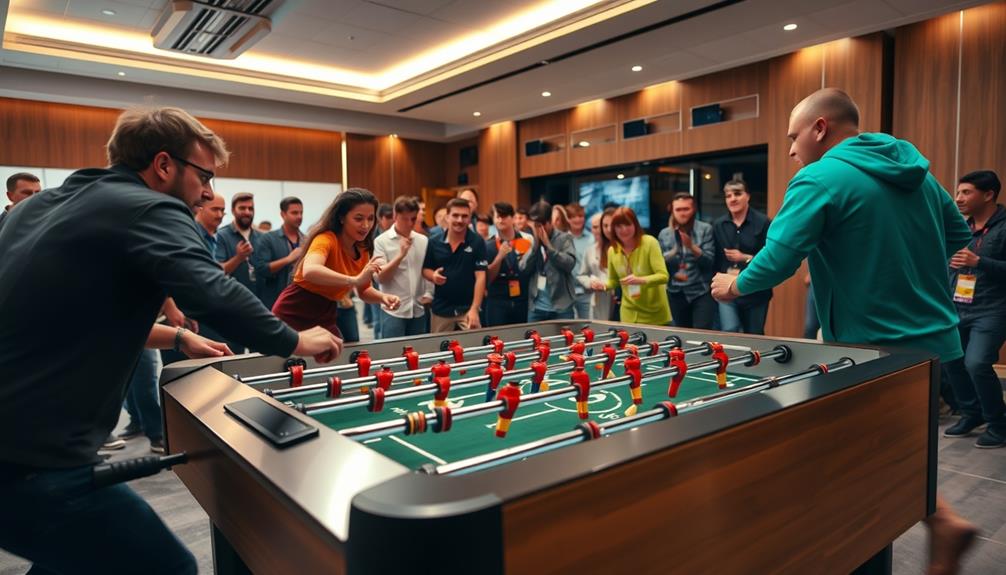In Skee‑Ball, your score depends on hitting targets in specific zones that have assigned point values, usually from 10 to 150 points, with higher points placed farther away. Bonus and jackpot scores can boost your total dramatically when you hit special targets or reach certain milestones. To maximize your points, focus on consistent aim and technique, aiming for high-value zones, and taking advantage of bonus rounds. Keep learning about the game’s layout and rules to increase your chances of big scores.
Key Takeaways
- Scoring zones are defined by target placement, with higher points awarded for more difficult, distant, or high-value targets.
- Point values vary based on target difficulty, with easier targets offering fewer points and harder ones offering more.
- Bonus mechanics, such as jackpots and bonus rounds, provide opportunities for quick, high scores.
- Strategic aiming at high-value zones and consistent shot control maximizes overall score.
- Proper technique, including aim, release, and equipment choice, improves accuracy and scoring potential.
The Basic Layout of a Skee‑Ball Alley

A Skee‑Ball alley is designed with a gently sloping lane that guides the ball toward the targets at the end. At the top, you’ll notice a ball ramp that helps you roll the ball smoothly into play. The lane directs your shot toward various scoring discs positioned near the targets. These discs are strategically placed to determine your score based on where the ball lands. As you roll, the ball travels down the ramp and onto the lane, aiming for the highest scoring zones. The setup encourages a natural flow, making it easy to control your shot and aim for specific scoring discs. This basic layout ensures a fun, skill-based game where precision and technique influence your score. Additionally, understanding the layout can help players better utilize scoring zones to maximize their points.
How Scoring Zones Are Determined
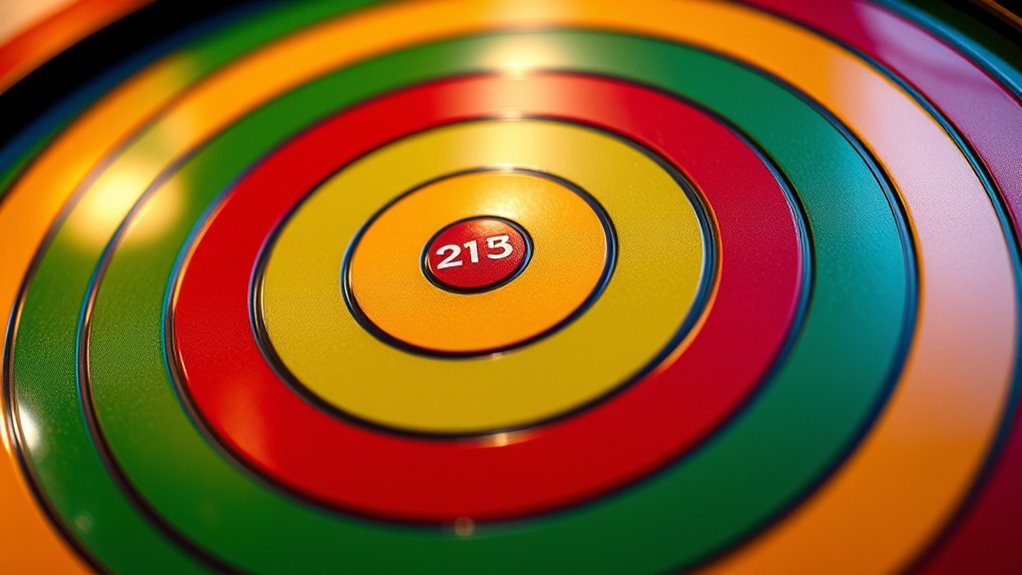
Scoring zones in Skee-Ball are determined by the placement and design of the targets at the end of the alley. Target zone calibration is key—manufacturers carefully position and size each zone to create consistent scoring opportunities. Variability in scoring zones occurs because some alleys may have slight differences in target placement or size, affecting how points are awarded. This scoring zone variability means you might see minor differences in scores across machines, even if they look similar. The calibration process ensures each zone corresponds accurately to its intended point value, providing a fair challenge. Understanding how these zones are set helps you better anticipate your shots and improve your game, knowing that each target’s placement influences your potential points.
Point Values for Each Target Area

Each target area in Skee-Ball has a specific point value that determines how many points you’ll earn when your ball lands there. These point values are designed to reflect the scoring history and target difficulty, with easier targets awarding fewer points and harder ones awarding more. Typically, the lower-value zones are close to the player, encouraging consistent scoring, while the high-value targets are more challenging, requiring precision and skill. Understanding these point assignments helps you strategize your throws to maximize your score. The scoring history of the game shows that players often prioritize targets with the best balance of risk and reward. By familiarizing yourself with each target’s point value, you can improve your game and aim for higher scores efficiently. Exploring the paranormal aspects of game strategies can reveal surprising insights into player behavior and decision-making.
The Significance of Bonus and Jackpot Scores
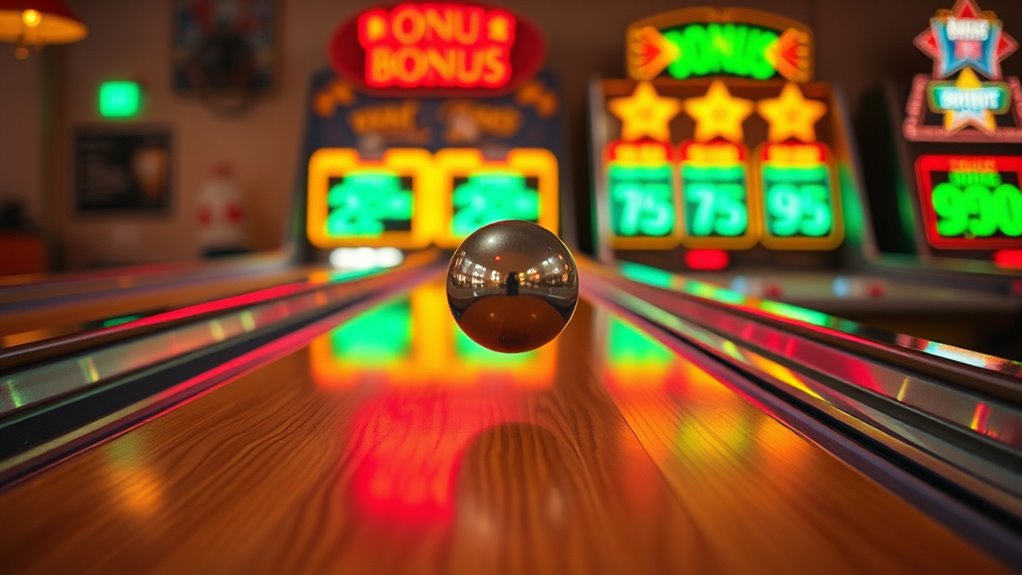
Bonus scores can give your total a quick boost, making it easier to reach high rankings. Hitting the jackpot can substantially increase your final points, sometimes turning a good game into a great one. Understanding how these scores work helps you maximize your overall performance and winnings. Incorporating strategic plays with score multipliers can further enhance your total score and overall success.
Bonus Score Mechanics
Understanding how bonus and jackpot scores work is vital to maximizing your points in Skee-Ball. Special scoring often occurs during bonus rounds, where your performance can unblock extra points. These bonus scores boost your total, rewarding skillful play. During bonus rounds, hitting specific targets or achieving certain milestones triggers additional points, emphasizing the importance of consistent accuracy. Recognizing the scoring mechanisms allows players to develop strategies that capitalize on bonus opportunities and optimize their overall performance.
| Bonus Round Trigger | Extra Points Earned |
|---|---|
| Achieving a set score | Extra points |
| Hitting designated targets | Bonus points |
| Completing a sequence | Extra points |
| Unblocking a jackpot | Large bonus score |
Focusing on these mechanics helps you leverage bonus rounds, turning small successes into big gains and boosting your overall score efficiently.
Jackpot Impact on Total
Jackpot scores can substantially boost your overall points in Skee-Ball, often acting as game-changers during high-stakes rounds. The jackpot influence introduces a significant scoring variation, making the game more exciting and unpredictable. When you hit the jackpot, it can double or triple your current score, dramatically altering your standing. Keep in mind these key factors: 1. Jackpot scores often come with bonus opportunities, increasing their impact. 2. The scoring variation caused by jackpots can lead to dramatic comebacks or losses. 3. Timing your jackpot shot matters—late-game jackpots can maximize points. 4. Understanding the scoring system helps you strategize for higher scores and better game outcomes. Mastering how jackpots affect your total score enhances your overall gameplay and scoring efficiency.
Strategies for Maximizing Your Points
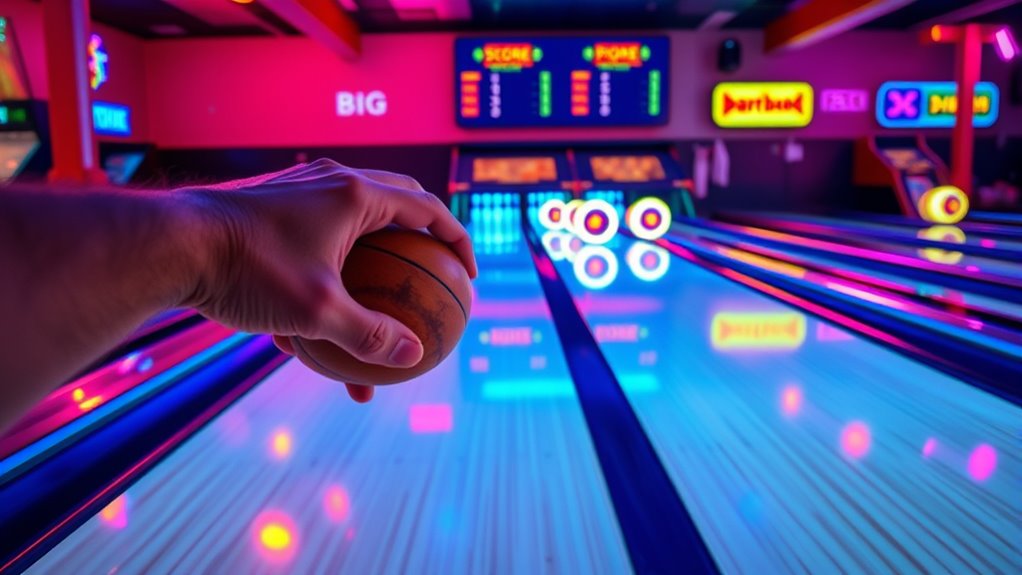
To maximize your points in Skee‑Ball, focusing on consistent shot placement is essential. Aim your throws so the ball rolls smoothly along the ball ramp, ensuring better control and accuracy. Use the scoring system to target higher-value holes, like the 100 and 150-point zones, rather than just aiming for the lower scores. Practice your release to develop a reliable arc that consistently hits your desired spots. Adjust your stance and follow-through to improve precision. Remember, the ball ramp guides your shot, so understanding how it affects ball speed and direction can help you fine-tune your aim. By concentrating on steady, controlled throws and understanding the scoring system, you’ll boost your chances of racking up more points each game. Incorporating professional voice techniques can also help you develop a more consistent delivery and improve your overall game.
Common Rules and Penalties to Keep in Mind
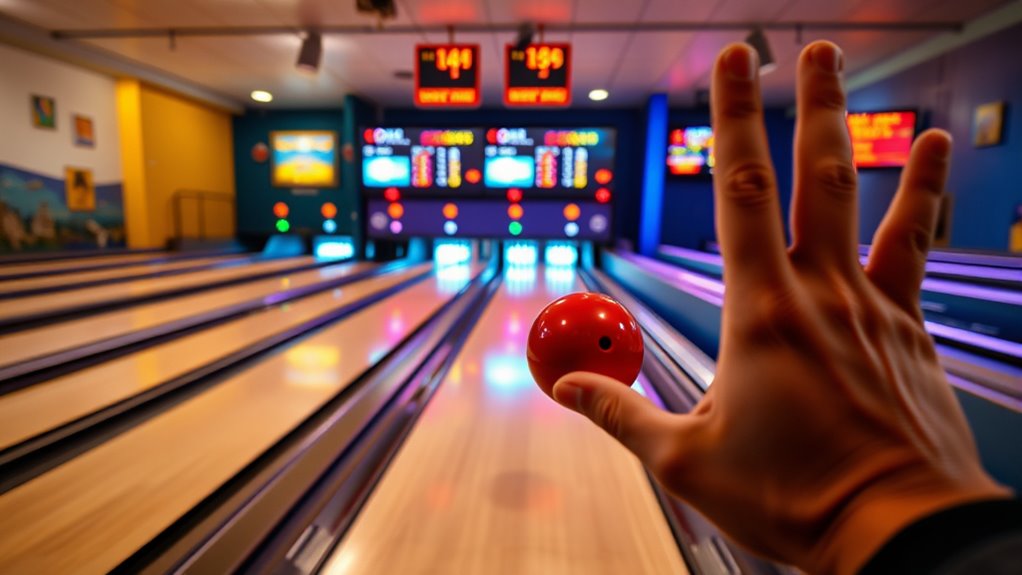
While playing Skee‑Ball, it’s important to familiarize yourself with the game’s rules and potential penalties to avoid losing points or disqualifications. Common rules include avoiding foul line violations, which can result in score deductions or nullified throws. To stay on track, keep these points in mind:
- Always release the ball behind the foul line to prevent penalties.
- Multiple fouls can lead to disqualification.
- Be aware of specific scoring penalties for touching the ball with your hand after releasing it.
- Follow the designated throw zone to avoid penalties that could reduce your score.
- Recognizing the importance of rules and penalties helps you prevent scoring issues and keeps your game fair and fun.
Understanding these rules helps you prevent scoring penalties and keeps your game fair and fun. Staying mindful of foul line violations ensures you maximize your points without risking disqualification.
Tips for Improving Your Skee‑Ball Skills
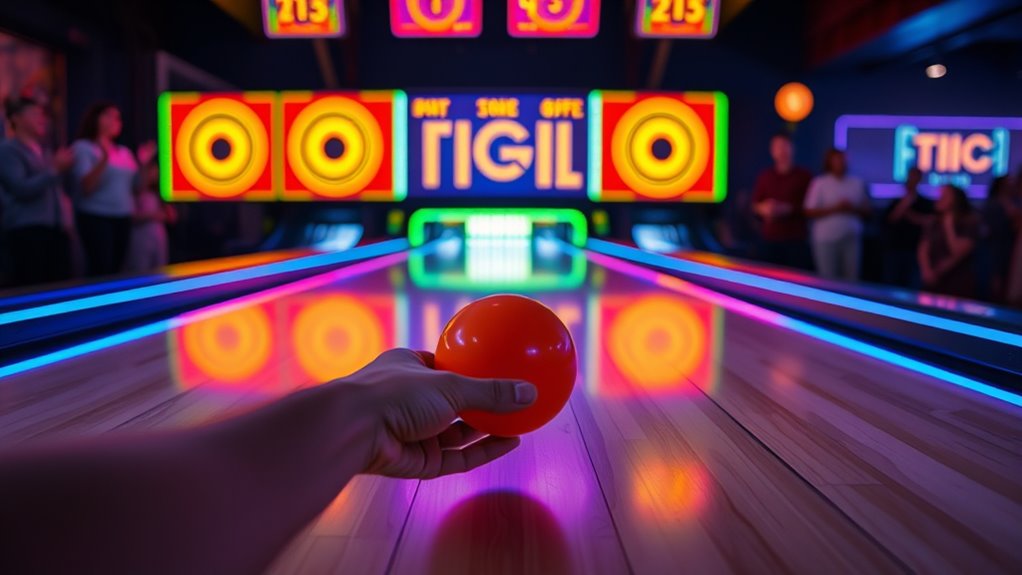
To boost your Skee‑Ball score, focus on perfecting your throw technique to increase consistency. Aim for high-value targets to maximize your points with each roll. Small adjustments can make a big difference in your overall performance. Incorporating precision and focus into your game can help improve your accuracy and overall score.
Perfect Your Throw Technique
Improving your skee-ball throw starts with mastering proper technique, which can substantially boost your accuracy and score. A consistent throw helps build your scoring history and positively influences player psychology, making each game more focused. To perfect your technique:
- Keep your stance balanced and comfortable for steady control.
- Use a smooth, controlled motion rather than a forceful throw.
- Focus on releasing the ball at the same point each time.
- Adjust your aim based on previous scoring patterns, learning from your history.
- Pay attention to wave and wind conditions that can subtly affect your throw trajectory.
Aim for High-Value Targets
Targeting high-value scoring areas can substantially boost your overall points in skee-ball. To do this effectively, pay attention to the ball design and how it interacts with the scoring equipment. Different balls may have varying weights and grip, influencing your throw accuracy. Aim for the upper or center targets on the game’s layout, as they typically offer higher points. Focus on consistent throws that land softly in these zones, maximizing your chances of hitting the highest scores. Adjust your aim based on the ball’s design and how it reacts when it hits the scoring equipment. Practice targeting these high-value areas to improve precision and confidence. Remember, consistently hitting the top targets can dramatically increase your overall score and give you an edge in the game.
Frequently Asked Questions
How Are Tie Scores Resolved in Skee‑Ball Competitions?
When a tie occurs in skee-ball competitions, tiebreaker procedures come into play. You might need to replay the round or have players shoot additional balls to determine the winner. Sometimes, scoring adjustments are made, such as adding bonus points or comparing individual high scores. These methods help guarantee fairness, so you can confidently settle ties and declare a clear winner based on the agreed-upon rules.
Do Different Skee‑Ball Machines Have Varying Scoring Systems?
You might wonder if different skee-ball machines have varying scoring systems. The answer is yes; scoring variation can occur due to machine calibration differences. Each machine can be set up slightly differently, affecting how points are awarded for each target. These variations mean that scores may not be directly comparable across machines, so operators often calibrate machines to guarantee consistent scoring and fair play during competitions.
Can Players Influence Scoring Zones During Gameplay?
Imagine you’re aiming for high-scoring zones in Skee-Ball. While you can’t change the scoring zones during gameplay, your strategies matter. Skilled players learn how to target specific areas, but machine calibration influences how easy or hard these zones are to hit. So, your success depends on understanding how the machine is set up and adjusting your aim accordingly, maximizing points within the fixed scoring zones.
Are There Age or Skill Restrictions for High-Score Challenges?
When it comes to high-score challenges, you won’t find strict age or skill restrictions, but player demographics and skill development do matter. Younger players or beginners might find it tougher to reach top scores, while more experienced players can leverage their skills to excel. These challenges often encourage all skill levels to participate, helping everyone improve through practice. So, focus on honing your skills and enjoying the game, regardless of age.
How Are Bonus and Jackpot Scores Awarded or Triggered?
When it comes to bonus and jackpot scores, you need to keep your eyes peeled—these are the real game changers. Bonus points are usually awarded for hitting specific targets or completing challenges during gameplay, while jackpot triggers happen when you score in a designated area or achieve a special combo. Stay focused and aim carefully, because hitting those jackpot triggers can dramatically boost your total score and boost your chances of winning big.
Conclusion
Mastering skee-ball isn’t just about points; it’s about understanding the game’s rhythm and symbols. Each target is a chapter, each score a story waiting to unfold. When you see the alley as a path rather than just a game, you release your true potential. Keep practicing, stay focused, and let each throw be a step toward more than just a high score—it’s a journey toward becoming part of the game’s timeless dance.


